Eutech instruments ALPHA -pH2000 Manual
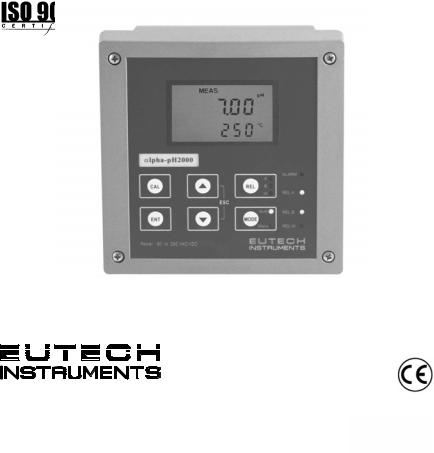
Instruction Manual
α lpha-pH2000
pH and ORP Controller/Transmitter
Technology Made Easy ...
68X216830 rev0 06/02
Preface
This manual serves to explain the use of the α lpha-pH2000 series pH/ORP controller/transmitter. The manual functions in two ways, firstly as a step by step guide to help the user operate the instrument. Secondly, it serves as a handy reference guide. This instruction manual is written to cover as many anticipated applications of the α lpha-pH2000 pH/ORP controller/transmitter. If you have doubts in the use of the instrument, please do not hesitate to contact the nearest Eutech Instruments’ Authorised Distributor.
The information presented in this manual is subject to change without notice as improvements are made, and does not represent a commitment on part of Eutech Instruments Pte Ltd.
Eutech Instruments cannot accept any responsibility for damage or malfunction of the unit due to improper use of the instrument.
Copyright 2002 Eutech Instruments Pte Ltd. All rights reserved.
2

Safety Information
The Eutech Controller/ Transmitter shall be installed and operated only in the manner specified in the Instruction manual. Only skilled, trained or authorized person should carry out installation, setup and operation of the instrument.
Before powering up the unit, make sure that power source it is connected to, is as specified in the top label. Failure to do so may result in a permanent damage to the unit.
The unit has live and exposed parts inside. If it has to be opened, make sure that the power to the unit is off and disconnected.
The unit is Fuse protected. In the event the fuse has to be replaced, use only those as specified in the manual.
The degree of protection against electric shock will be achieved only by observance of the corresponding installation rules.
3
TABLE OF CONTENTS
1 INTRODUCTION |
6 |
||
|
|
|
|
1.1 |
At the very beginning |
6 |
|
1.2 |
Intended use |
6 |
|
1.3 |
Safety intsructions |
7 |
|
2 PRODUCT DESCRIPTION |
8 |
||
|
|
|
|
2.1 |
Description of unit |
8 |
|
2.2 |
Measurement and Control System |
9 |
|
2.3 |
Unit Overview |
10 |
|
3 |
|
ASSEMBLY AND INSTALLATION |
14 |
|
|
3.1 |
Mounting the unit |
14 |
|
|
3.2 |
Connection Diagram |
15 |
|
4 |
|
NORMAL OPERATION |
16 |
|
5 |
|
CALIBRATION MODE |
17 |
|
|
5.1 |
Entering Calibration mode |
17 |
|
|
5.2 |
pH Calibration |
18 |
|
|
5.3 |
ORP–mV Calibration |
20 |
|
|
5.4 |
ORP -% Calibration |
21 |
|
|
5.5 |
View actual zero and slope |
22 |
|
6 |
|
SET-UP MODE |
23 |
|
|
6.1 |
Enter Setup mode |
23 |
|
|
6.2 |
Electrode Offset (OFS) sub-function |
24 |
|
|
6.3 |
Setting temperature (Set oC) sub-function |
25 |
|
|
6.4 |
Control Relay A/Control Relay B (SP1/SP2) sub-function |
26 |
|
|
6.5 |
Controller (CNTR) sub-function |
28 |
|
|
6.6 |
Current Output 1 sub-function |
31 |
|
|
6.7 |
Current Output 2 sub-function |
32 |
|
|
6.8 |
Wash relay (WASH) sub-function |
33 |
|
|
6.9 |
Configuration (CNFG) sub-function |
34 |
|
|
6.10 |
Calibration (CAL) sub-function |
36 |
|
7 |
|
RELAY MODES |
37 |
|
|
7.1 |
View relay set points |
37 |
|
|
7.2 |
Manual relay mode |
38 |
|
8 |
|
TECHNICAL SPECIFICATIONS |
39 |
|
9 |
|
ACCESSORIES |
40 |
|
4
10 GENERAL INFORMATION |
41 |
||
|
|
|
|
10.1 |
Warranty |
41 |
|
10.2 |
Packaging |
41 |
|
10.3 |
Return of Goods |
41 |
|
10.4 |
Guidelines for Returning Unit for Repair |
41 |
|
11 APPENDICES |
|
42 |
||
|
|
|
|
|
11.1 |
Appendix 1 – Pt 100 / Pt 1000 selection |
42 |
||
11.2 |
Appendix 2 |
– pH buffer values at various temperatures |
43 |
|
11.3 |
Appendix 3 |
- Hysteresis |
44 |
|
11.4 |
Appendix 4 |
– Control actions |
45 |
|
11.5 |
Appendix 5 – Abbreviations used in menu displays |
47 |
||
5

1 INTRODUCTION
1.1At the very beginning
We thank you for having purchased the Eutech Instruments alpha pH 2000 pH/ORP Controller.
The construction of the pH/ORP Transmitter employs leading edge technology and complies with safety regulations currently in force. Notwithstanding this, improper use could lead to hazards for the user or a third-party, and/or adverse effects on the plant or other equipment. Therefore, the operating instructions must be read and understood by the persons involved before work is started with the pH/ORP Transmitter.
This instruction manual identifies safety instructions and additional information by means of the following symbols:
)–
–
This symbol draws attention to safety instructions and warnings of potential danger which, if neglected, could result in injury to persons and/or damage to property.
This symbol identifies |
additional information and |
instructions |
which, |
if |
neglected, could lead |
to inefficient operation |
and possible |
loss |
of |
production. |
|
|
|
|
The instruction manual must always be stored close at hand, in a place accessible to all people working with the pH/ORP Transmitter.
If you have questions, which are not or insufficiently answered in this instruction manual, please contact your Eutech Instruments supplier. They will be glad to assist you.
1.2Intended use
Eutech Instruments alpha pH 2000 pH/ORP Transmitters are intended solely for pH or ORP and temperature measurement, as described in this instruction manual.
Any other use, or use not mentioned here, that is incompatible with the technical specifications is deemed inappropriate. The operator is solely responsible for any damage arising from such use.
Other prerequisites for appropriate use include:
–observing the instructions, notes and requirements set out in this instruction manual.
–observing all local safety regulations concerning safety at work.
–observing all information and warnings in the documentation dealing with the products used together with the transmitter (housings, sensors, etc.).
6

– observing the prescribed environmental and operational conditions.
1.3Safety instructions
The pH/ORP Transmitter should be installed and operated only by personnel familiar with the transmitter and who are qualified for such work.
A defective transmitter must neither be installed nor put into service.
The pH/ORP Transmitter must only be operated under the specified operating conditions (see section 8).
The pH/ORP Transmitter must not be opened nor repaired by the customer.
No modifications to the pH/ORP Transmitter are allowed. The manufacturer/supplier accepts no responsibility for damage caused by unauthorised modifications. The risk is borne entirely by the user.
7

2 PRODUCT DESCRIPTION
2.1Description of unit
The Eutech pH/ORP Transmitter is used for measuring pH or ORP and temperature values. The pH or ORP values can be measured using proportional or limit control.
The transmitter is available in two versions, one for panel mounting and one for wall mounting in an enclosure. The transmitter can be used for applications such as water treatment and monitoring, galvanic-decontamination, chemical processing, food processing, clean or wastewater control and neutralization processes.
This transmitter has many user-friendly and safety features which include:
•Menu-driven program that simplifies set-up.
•Built-in memory backup to ensure that calibration and other information are not erased if power supply fails.
•Push-button for calibration and electrode offset adjustment from the keypad.
•Automatic temperature compensation (ATC).
•Manual temperature compensation setting without the ATC probe, with independent setting for calibration and process temperature.
•Two galvanically isolated current outputs 0/4...20mA
•0 to 1999 seconds time delay adjustment on all relays – minimizes false alarms.
•Separately adjustable high and low set-point hysteresis (dead bands) prevent chattering of relays around the set points.
•Asymmetrical/symmetrical input for pH/ORP mode of operation.
•Three control modes: limit controller, P controller and PI controller (P/PI controller as pulse length or pulse frequency).
•Large dual display LCD for easy reading with clear multiple annunciators, alarm status, operational and error messages.
•Two switching contacts as set-point relays.
•Separate alarm relay alerting you to set point limits exceeded for a certain time and if the Pt100/Pt1000 wires are broken or disconnected during the ATC function.
•Wash relay.
•Hold function to freeze output current (0/4...20mA) and release control relays.
•LED indicators signal control activities to visually monitor transmitter status from a distance.
•Protection against electromagnetic interference.
•Back lighted and UV light protected LC display
8
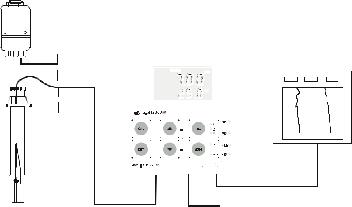
2.2 Measurement and Control System
A typical measurement system consists of:
•a pH/ORP process transmitter
•a pH/ORP combination electrode with integrated or separate temperature sensor Pt 100/1000,
•an appropriate pH or ORP measurement cable
•an immersion, flow or process assembly with or without a potential matching pin (PMP)
•a final control element such as pump or valve
•a chart recorder
Flow Assembly
pH Controller
Chart Recorder
|
|
|
|
|
|
|
|
|
|
|
|
|
|
|
|
|
|
|
|
|
|
|
|
|
|
|
|
|
|
|
|
|
|
|
|
|
|
|
|
|
|
|
|
|
|
|
|
|
|
|
|
|
|
|
|
|
|
|
|
|
|
|
|
|
|
|
|
|
|
|
|
|
|
|
|
|
|
|
|
|
|
|
|
|
|
|
|
|
|
|
|
|
|
|
|
|
|
|
|
|
|
|
|
|
|
|
|
|
|
|
|
|
|
|
|
|
|
|
|
|
|
|
|
|
|
|
|
|
|
|
|
|
|
|
|
|
|
|
|
|
|
|
|
|
|
|
|
|
|
|
|
|
|
|
|
|
|
|
|
|
|
|
|
|
|
|
|
|
|
|
|
|
|
|
|
|
|
|
|
|
|
|
|
|
|
|
|
|
|
|
|
|
|
|
|
|
|
|
|
|
|
|
|
|
|
|
|
|
|
|
|
|
|
|
|
|
|
|
|
|
|
|
|
|
|
|
|
|
|
|
|
|
|
|
|
|
|
|
|
|
|
|
|
|
|
|
|
|
|
|
|
|
|
|
|
|
|
|
|
|
|
|
|
|
|
|
|
|
|
|
|
|
|
|
|
|
|
|
|
|
|
|
|
|
|
|
|
|
|
|
|
|
|
|
|
|
|
|
|
|
|
Power Mains |
|
|
|
|
|
|
|
|
|
|
|
|
|
|
|
|
|
|
||
Process Assembly |
|
|
|
|
|
|
|
|
|
|
|
|||||||
Measurement Cable |
|
(220/110 VAC) |
||||||||||||||||
with Electrode |
|
|
|
|||||||||||||||
|
|
|
|
|
|
|
|
|
|
|
|
|
||||||
9
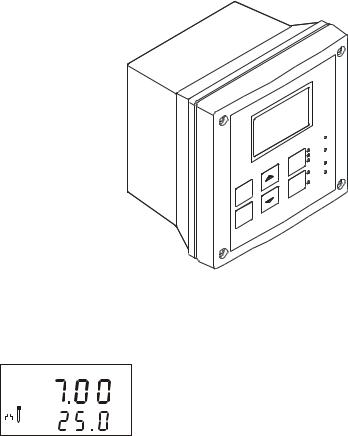
2.3 Unit Overview
Wall mounting version
2.3.1Display overview
The LC display shows two alpha-numerical fields for parameters and measured values as well as various mode and status indicators.
SETUP MEAS |
CAL |
mv |
|||
PH% |
|||||
ready |
|
||||
HOLD |
|
|
|||
err |
|
|
|||
|
|
|
|
OCOf |
|
|
|
|
|
ph |
|
s |
|
atc |
|||
|
|
||||
Mode indicators:
–MEAS: Measurement mode
–SETUP: Set-up mode
–CAL: Calibration mode
Status indicators:
–READY: Visible after successful calibration
–HOLD: Relay position and current output are frozen
–ATC: Visible in ATC (Automatic Temperature Compensation) mode. Not visible in the Manual temperature compensation mode. “ATC” flashes if the temperature probe is faulty in its ATC mode
–ERR: Error or alarm indicator
–S: Visible in symmetrical measurement mode
10

2.3.2Key functions
Key
CAL
Description
• Enter Calibration mode (requires access code)
• Enter Set-up mode (requires access code)
• Access sub functions (parameters) within a function group of Set-up mode
• Confirm (store) set-up parameters and numerical values
• Start calibration in Calibration mode
• Select function group in the Set-up mode.
• Set parameters and numerical values
(if key is pressed continuously, the setting speed increases)
• Control the relays in MANUAL relay operation
• Returns to “Measurement mode” when both keys are pressed simultaneously
• Display limit values for SP1 and SP2 and settings for wash contact in AUTO relay operation
• Toggle between RELAY A, RELAY B or Wash relay in MANUAL relay operation
• Switch from AUTO to MANUAL relay operation (requires access code)
2.3.3LED indicators
Relay indicators
A |
If REL key is pressed the LED (A, B or W) indicates to which Relay (A, B or |
B |
Wash) the displayed limit values refer |
W |
|
Relay mode indicators
 Auto Auto LED lights if relay operation is set to automatic mode.
Auto Auto LED lights if relay operation is set to automatic mode.
 Man Man LED lights if relay operation is set to manual mode.
Man Man LED lights if relay operation is set to manual mode.
11

Relay status indicators
Alarm: LED lights if limit value is exceeded or the ATC probe fails.
Rel A: LED lights green if measured value is within limit for Relay A
LED lights red if measured value exceeds limit for Relay A
Rel B: LED lights green if measured value is within limit for Relay B
LED lights red if measured value exceeds limit for Relay B
Rel W: LED lights if cleaning cycle is on.
2.3.4Security codes
The access to Calibration mode, Setup mode and Manual relay operation mode is protected with security codes. The security codes are set at the factory and cannot be changed by the user. The following security codes are used:
Security code |
Mode/Description |
|
|
000 |
View only mode to view actual settings |
|
|
11 |
Calibration mode to start calibration |
22 |
Setup mode to configure parameters |
22 |
Manual relay operation to switch relay operation mode from |
|
automatic to manual |
12
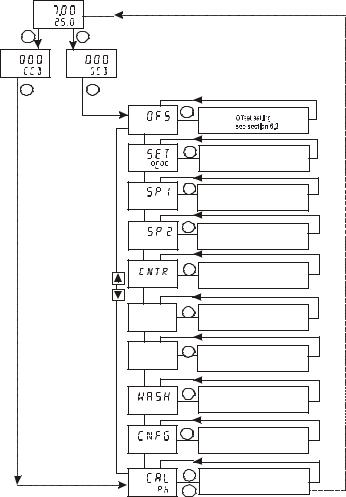
2.3.5Menu overview
MEAS |
|
P H |
|
C |
|
|
|
* |
** |
|
|
*CCD “000”= Check calibration parameters (View only mode) CCD “11” = Calibration
**SCD “000” = Check setup parameters (View only mode) SCD “ 22” = Setup mode
SETUP
HOLD
SETUP |
|
|
Temperature settings |
HOLD |
|
|
|
|
|
|
see section 6.3 |
SETUP |
|
|
|
HOLD |
|
|
|
SETUP |
|
|
|
HOLD |
|||
|
|
||
SETUP |
|
|
|
HOLD |
|
|
SETUP
HOLDcur.1
Relay A (set point 1) settings see section 6.4
Relay B (set point 2) settings see section 6.4
Controller settings see section 6.5
Current output 1 settings see section 6.6
SETUP |
|
|
|
HOLDcur.2 |
|
|
Current output 2 settings |
|
|
|
see section 6.7 |
SETUP |
|
|
Wash contact settings |
HOLD |
|
|
|
|
|
|
see section 6.8 |
SETUP |
|
Unit settings |
HOLD |
|
|
|
|
see section 6.9 |
SETUP |
|
|
Calibration |
HOLD |
|
|
|
|
|
|
see section 5 |
13
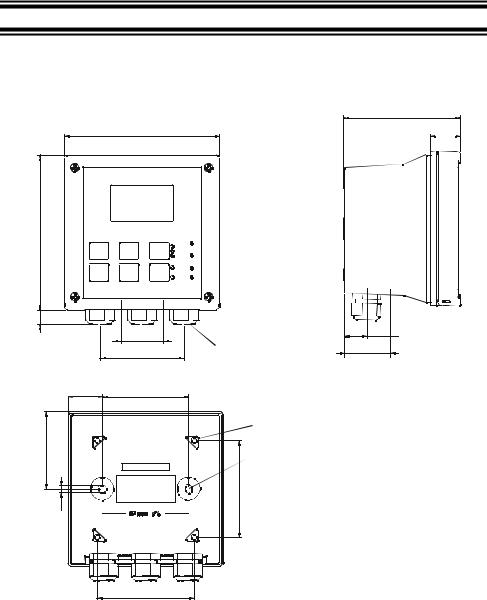
3 ASSEMBLY AND INSTALLATION
3.1Mounting the unit
|
108.50 |
144 |
27.50 |
144
14 |
|
|
approx. |
78 |
PG13.5 (3 pcs.) |
|
39 |
|
21.13 |
42.36 |
32 |
80 |
|
Holes for panel |
|
mounting (4X) |
72 |
Holes for wall |
|
mounting (2X) |
|
90 |
6 |
|
90 |
14

3.2Connection Diagram
Caution: Ensure electrical mains is disconnected before proceeding. The back panel consists of three connectors.
pH/ mV
|
|
|
|
|
|
|
PT100/ |
|
|
|
RE LA |
|
RELB |
WASH RE LAY |
ALAR M R ELAY |
||||
|
|
|
|
|
|
|
|
|
|
|
|
|
|
|
|
|
|
||
|
|
|
|
|
|
|
PT1000 |
|
|
|
|
|
|
|
|
|
|
|
|
|
|
|
|
|
|
|
|
|
|
|
12 |
11 |
10 |
9 |
8 |
7 |
4 |
5 |
6 |
29 |
28 |
31 |
30 |
20 |
19 |
22 |
24 |
25 |
26 |
27 |
14 |
13 |
|
|
|
3 |
|
2 |
1 |
+- + -
Current |
Current GND +12V |
E |
LIQ |
HOLD |
E |
N L |
OP 2 |
OP1 |
|
GND |
|
|
|
1. |
AC mains live wire |
17. no connection |
|
2. |
AC mains neutral wire |
18. no connection |
|
3. |
AC mains protective earth wire |
19. |
12V Power supply |
4. |
Alarm relay working position (NC) |
20. |
12V ground |
5. |
Alarm relay common |
21. no connection |
|
6. |
Alarm relay resting position (NO) |
22. |
Earth ground |
7. |
Wash relay |
23. no connection |
|
8. |
Wash relay |
24. |
Temperature ground |
9. |
Relay B (SP 2) |
25. |
Temperature input |
10. |
Relay B (SP 2) |
26. |
Temperature sense (short to terminal 25 if using 2- |
11. |
Relay A (SP 1) |
|
wire RTD |
12. |
Relay A (SP 1) |
27. |
PMP, liquid ground in symmetrical mode |
13. |
Hold function |
28. |
4-20 mA temperature output, -ve terminal |
14. |
Hold function |
29. |
4-20 mA temperature output, +ve terminal |
15. no connection |
30. |
4-20 mA pH output, -ve terminal |
|
16. no connection |
31. |
4-20 mA pH output, +ve terminal |
|
IMPORTANT: The Alarm relay functions as an “Active Low” device i.e. it switches OFF under Alarm condition. Therefore the Alarm display device should be connected to the ‘NC’ contacts of the relay (4 & 5).
15
